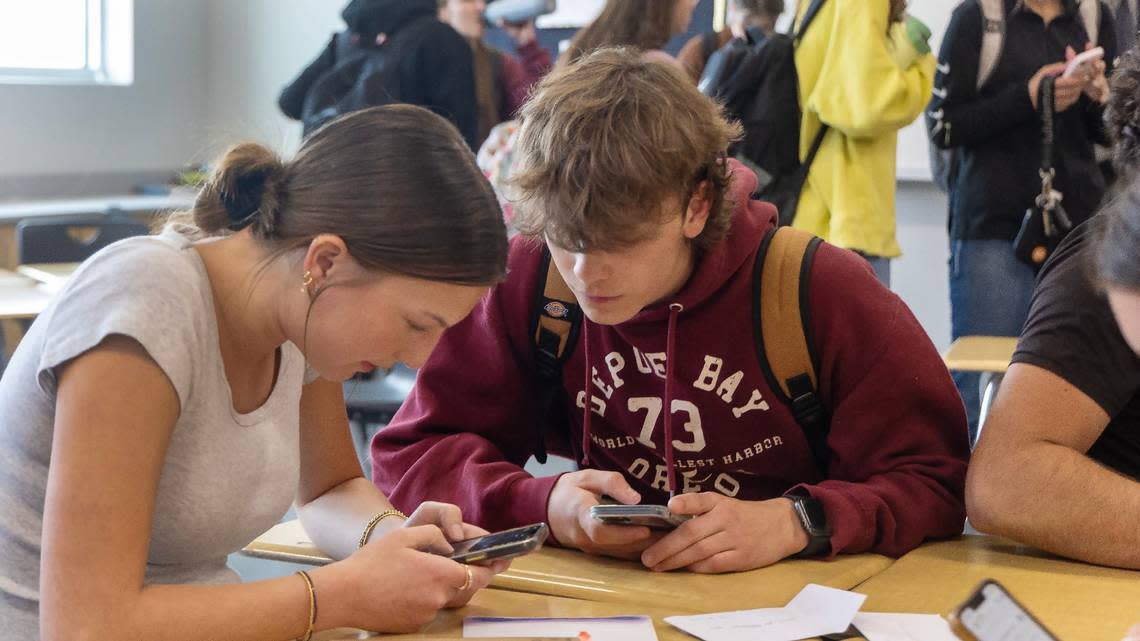West Ada considers a policy to bar cellphone use in the classroom. Will Boise follow?
Students at Owyhee High School walk into their classes, some lingering in the doorway for a few seconds to take final glances at their cellphones. Then, they drop their devices into 36-slot blue pocket holders at the entrance of their classrooms and sit down.
It’s a system they know well. Owyhee, in the West Ada School District, has had a cellphone policy since it opened three years ago. Students are required to drop their phones at the beginning of class and can take them back at the end — sometimes getting a few seconds before the bell to send messages or check their notifications.
The policy is an effort to create an environment where students can focus on instruction.
“If you talk to any educators, the bane of our existence is cellphones,” Owyhee Assistant Principal Scott Connors told the Idaho Statesman. “There’s plenty of research out there about the cellphone, and how often it distracts us. So how do we expect kids to engage in lessons and to learn if we’re not taking away one of the objects that we know is going to distract them?”
The West Ada School District could pass a similar policy districtwide. If the school board approves the draft policy and procedures — which could take effect next school year — the district will join several others across the state that have already adopted policies to eliminate the distractions cellphones pose in the classroom. More could soon follow.
The effort to adopt stricter cellphone policies is part of a nationwide movement stemming from research and studies that show removing cellphones from the classroom can help boost engagement and focus in class, and improve mental health. It could also contribute to a decrease in cyberbullying.
A Surgeon General’s advisory last year warned social media could have a “profound risk of harm to children’s mental health.” According to a national Pew Research Center Survey, nearly half of teens surveyed said they were online “almost constantly.”
Parents, teachers and administrators in support of policies that would ban cellphone use throughout the school day in Idaho say it would create environments that allow teachers to do their job with far fewer distractions and is an important step to helping students learn and feel better during the day.
“We all have access to technology from morning till night,” said Kim Washington, a parent in the Boise School District advocating for a “bell to bell” cellphone ban. “Kids need a break during the day, and they’re there to learn and they’re there to learn how to have face-to-face connections and interactions.”
And administrators say while students may grumble at first, many end up appreciating not having to pay attention to their phone during school hours and knowing their peers won’t be either.

Parents opposed to these policies worry about not being able to contact their kids directly at all times, especially in the event of an emergency. But administrators said parents can always contact the front office, and that it could be more dangerous for students to be distracted by their phones during emergency situations.
‘A really logical step’
The West Ada School District has been developing a policy to get cellphones out of the classroom for months. Trustee David Binetti said he first brought up the idea last year.
The West Ada policy, as drafted, would direct the superintendent or a designee to create procedures to limit students’ access to cellphones and other personal electronic devices during instructional time. Administrative regulations associated with the policy would require that phones not be kept on students during instructional hours, and that each school or classroom designate a place students would put their devices before the start of class. That could include lockers, baskets or other types of storage areas.
Teachers would have discretion to allow students to use their phones during class if it’s for instruction, or in emergency situations. Smartwatches don’t have to be put in the designated storage areas, but must be off during instructional periods, and students could face consequences for using the watches in class, according to the policy.
The goal is to keep the focus on learning, Binetti said.
“Cellphones can be great, but they are also probably the biggest distraction there is,” he told the Statesman. “And so removing them from the instructional environment seemed like a really logical step.”
Other schools and districts have similar policies. Last year, the Blaine County School District updated its policy to prohibit cellphone use during the school day. Students in the district can’t have their phones on them throughout the day, but high school students are allowed to use their phones during their lunch period, according to the policy.
Some charter schools in the Treasure Valley also have cellphone policies. Anser Charter, for example, requires students in grades 6-8 to place devices in a secured lock box at the start of each school day. Elementary students must give their phones to their “crew leader” at the start of the day.
Many schools have also already developed their own systems even without a districtwide policy.
Owyhee’s pocket holders are called VAULTs, which stands for “Valuing Academics, Utilizing Learning Time.” The holders hang on the wall of each classroom and students have designated numbered slots. Students can’t access their phones unless directed by the teacher.
Sheridan Berg, an English teacher at Owyhee, said the system has been effective and encourages students to interact more with each other.
“It’s funny because it seems like usually that last bit when phones are grabbed again, the last minute or so, that it’s almost the quietest that it’s been the whole class period,” she said, “just because that’s what they’re more focused on.”

Boise parents push for conversation on tech
In the Boise School District, a group of parents is pushing to start a conversation about cellphone use in schools and to educate other parents about potential impacts.
Parents wrote a letter earlier this year to the superintendent, school board and administrators that outlined four steps to help address the “growing need for mental health support” in schools and communities. The letter, which has been signed by nearly 300 people, said students need to “build authentic connections” to reduce social isolation and stress — and regulating technology use in school could be a good start.
“Excessive use (and misuse) of personal smart devices … play a big role in declines in mental health among all demographics,” the letter read.
Many schools in the district have their own policies to limit cellphone use during instructional time.
Several Boise parents said they have been concerned about the mental health impacts of technology and social media use for years, but that worry became even more acute after multiple students in the Treasure Valley died by suicide last year.
“There’s a lot of fear behind why parents want to reach their children all the time,” said Nicola Blair, one of the Boise parents who helped craft the letter. “But they forget the bigger picture of what’s happening every day. Like the mental health, the sextortion, the suicidal thoughts, the anxiety, depression, loneliness, predators, grooming online. … I feel it’s never ending.”
Parents who support cellphone bans in the classroom — and those who are choosing to wait to get their kids smartphones — acknowledged that they’re not against technology. But they said it’s important to help kids use them safely and to limit their use.
They said they would support policies that bar students from accessing their phones from the beginning to the end of the school day to better address student mental health — a step further than just limiting use during instructional time.
The Boise School District is looking at its policy and procedures around student cellphone use, spokesperson Ryan Hill said in an email. Now, teachers and schools in the district have a lot of flexibility for how they deal with this issue.
“Given that we serve students and families with a diverse range of backgrounds, we offer a multitude of educational approaches to ensure a high-quality education,” Hill said. “This is not an area where a simple, one-size-fits-all approach may work.”
But Hill said the district has been talking with parents, students and teachers to better understand the challenges and look at possible approaches that range from a total ban on phones throughout the day to providing “clearer direction and guidance.”
Boise parents spearheading the effort say they’re hopeful the district will take up this issue, and optimistic that there are hundreds of parents who are interested in joining the conversation.
“With all the research that is coming out, the momentum is there. The tide is turning,” said Tara Coffland, another Boise parent. “Our youth — they’re our future generation, and if they’re struggling with these mental health issues, we have to do something.”
